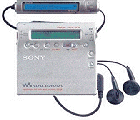Do you buy easy to use products?
By Richard Whitehand and Alexander Piatidis, August 2002
Have you ever been irritated by the time it takes you to set your video recorder to record a TV programme? Have you ever recorded the wrong channel or time? Maybe you've been baffled by the variety of buttons on a new microwave, not knowing which one to press?
If these sorts of situations seem unfamiliar to you in your encounters with modern consumer products, then you may be rather unusual compared to the population in general! Unfortunately today's "hi-tech" products, whilst perhaps having many useful functions, aren't always as easy to use as they should be.
 Quote from a dissatisfied consumer:
Quote from a dissatisfied consumer:
"When I bought this mini-disc player I appreciated its small size, functionality and reputable brand name. Once I had got it home and tried to use it then I became dismayed by its complexity, and how I always made mistakes when using common functions."
Note: Our own policy is to always return products with faulty usability!
The typical shop situation is far from ideal when it comes to judging the ease of use of a product. Often it is not possible to try out the product realistically in the shop - who would normally use a video recorder when standing next to it on a display rack, without a remote control?
How can customers know that they're buying a product that will be easy to use? An "easy to use" stamp, perhaps? This alone is unlikely to be the answer - many shops today advertise their products as "easy to use", with little real substance behind the claims.
However, ISO (the international standards organisation) is developing a new standard for the usability of consumer products (ISO CD 20282 - currently in early draft form). A product certified as "easy to use" through an ISO-based testing process should be more credible, and more importantly, provide a true indication of the ease of use of the product.
Advantages of product certification are:
- Actual ease of use, as opposed to apparent (or claimed) ease of use, can be used as a basis for product comparison.
- Consumers are given a more reliable means of assessing ease of use, even in the shop.
- More manufacturers will be encouraged to work with usability issues in a serious and structured manner.
At Usability Partners we believe that this coming ISO standard is a welcome development for users of all types of consumer products, whether they be new mobile devices or traditional kitchen appliances. With the goal of "making it easier to use", our usability specialists have therefore developed and trialled a testing methodology to support product assessment to the new ISO standard.
Our hope, of course, is that manufacturers will take such standards seriously and begin assessing their products during development. In the meantime, if you as a consumer buy a product and discover it is difficult to use then return it and demand a refund - a product with poor usability is poor quality product, regardless of the brand.
Did you find this editorial interesting?
You might like to read some of our other editorials.
Please send us an email if you have any comments or suggestions!